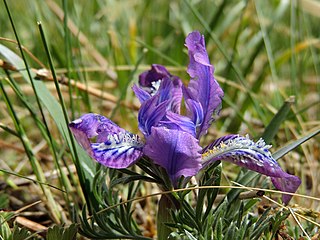
Gagea is a large genus of spring flowers in the lily family. It is found primarily in Eurasia with a few species extending into North Africa and one species in North America.

Gagea serotina, synonym Lloydia serotina, is an Arctic–alpine flowering plant of the lily family. It is widespread across the mountainous parts of western North America, from Alaska to New Mexico, and in Europe is found in the Alps and Carpathians, as well as in Great Britain. It is also native to much of Central Asia, Siberia, China, Nepal, Mongolia, Korea and Japan.

Hierochloe is a genus of plants in the grass family known generally as sweetgrass. These are perennial rhizomatous grasses found primarily in temperate and subarctic regions of Eurasia and North America, although some species extend southwards into Australia and Latin America.

Gagea liotardii is a Eurasian and North African species of plants in the lily family. It is a bulb-forming perennial up to 15 cm tall. Flowers are generally bright yellow to yellow-green. Its native range stretches from Spain and Morocco to Mongolia.
Allium leucocephalum is an Asian species native to Buryatiya, Zabaykalsky Krai, Mongolia, Inner Mongolia, Gansu, and Heilongjiang.

Iris uniflora is a species in the genus Iris and in the subgenus Limniris. It is a rhizomatous perennial, from Russia, Mongolia, China and Korea. It has thin grass-like leaves and stems, and purple, blue-purple or violet flowers. It is cultivated as an ornamental plant in temperate regions.

Gagea alberti is an Asian species of plants in the lily family, native to Kazakhstan, Kyrgyzstan and Xinjiang Province of western China.
Gagea altaica is an Asian species of plants in the lily family, native to Kazakhstan, Siberia, and Xinjiang Province of western China.

Gagea bulbifera is a Eurasian species of plants in the lily family, widespread from Romania to Xinjiang. It is native to Romania, Russia, South Caucasus, Kazakhstan, Kyrgyzstan, Iran, Turkey, Xinjiang, Western Himalayas.
Gagea divaricata is an Asian species of plants in the lily family, native to Kazakhstan, Kyrgyzstan, Tajikistan, Uzbekistan, and Xinjiang Province of western China.
Gagea fedtschenkoana is an Asian species of plants in the lily family, native to Russia, China (Xinjiang), Kazakhstan, and Mongolia.
Gagea filiformis is an Asian species of plants in the lily family, native to Russia, China (Xinjiang), Kazakhstan, Kyrgyzstan, Tajikistan, Uzbekistan, Afghanistan, Pakistan, and Mongolia.

Gagea granulosa is a Eurasian species of plants in the lily family. It is native to Russia, Kazakhstan, China (Xinjiang), and Mongolia.
Gagea nakaiana is an Asian species of plants in the lily family. It is native to northeastern China, Russia, Japan, Korea, Nepal, Bhutan, Pakistan, and northern India.
Gagea kunawurensis is an Asian species of plants in the lily family. It is native to Central Asia, Xinjiang, Afghanistan, Iran, Pakistan, Western Himalayas, and South Caucasus.
Gagea stepposa is a Chinese flowering plant in the lily family. It is found only in the northern part of Xinjiang Province in northwestern China.

Gagea hiensis is a species of flowering plant in the lily family. It is native to Korea, Mongolia, China, and Far Eastern Russia.
Gagea triflora is an Asian species of plants in the lily family. It is native to Japan, Korea, China, and Russia.

Iris tigridia is a plant species in the genus Iris; it is also in the subgenus Iris and in the section Pseudoregelia. It is a rhizomatous perennial, from Kazakhstan, Russia, Mongolia and China. It has dark green or greyish green, grass-like leaves, a short slender stem and a single flowers that are either violet, dark blue, blue-purple, dark purple, mauve, lilac, lavender, or light purple. It is cultivated as an ornamental plant in temperate regions.

Iris glaucescens is a plant species in the genus Iris and subgenus Iris. It is a rhizomatous perennial, found in Russia, Kazakhstan, Mongolia and China. It has blue-grey sickle-shaped leaves, slender stem, and spring flowers in blue-violet, pale violet, lilac-purple, to deep purple, to light bluish, and almost white shades. It is rarely cultivated as an ornamental plant in temperate regions. It was merged with another similar iris in the region, and became a synonym of Iris scariosa, before being divided into two separate species again, although some sources still call it a synonym of Iris scariosa.










